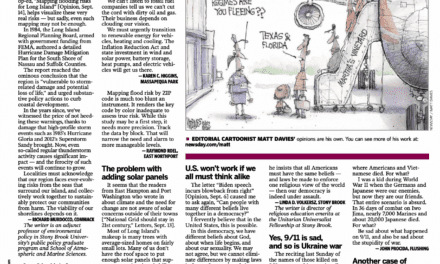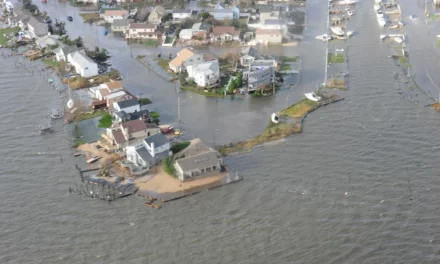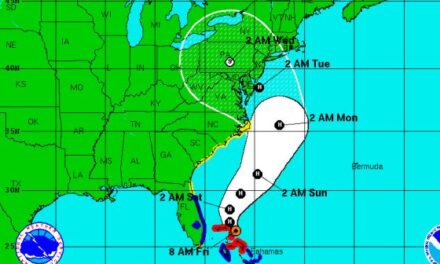The following was published exclusively on The Foggiest Idea on January 18, 2019. Want to support The Foggiest Idea’s award-winning coverage? Click here.
But If We Do Nothing, Region Will Be Up A Creek Without a Paddle
By Richard Murdocco
Fighting for water quality is “the most important priority” of his administration, declared Suffolk County Executive Steve Bellone in January 2014. Subsequently, he designated nitrogen as “public enemy number one.”
Since then, taskforces were formed, commissions were launched, and environmental policies and plans were drafted. So, the question remains – are we winning the fight to clean our waters?
To hear county government officials and some environmental advocates, the answer is yes.
“Over the past several years Suffolk and its partners in the environmental and business communities have made significant progress in the effort to reverse decades of nitrogen pollution,” Bellone wrote in an April 2018 op-ed for the Long Island Press.
This improvement, Bellone argued, was largely based on the mechanisms the county had established for homeowners to replace cesspools with Innovative and Alternative Onsite Wastewater Treatment Systems, or I/A OWTS for short. “Just as important,” he stated, “are the county’s efforts to reduce the cost of the new systems for homeowners.”
As it stands, wastewater treatment isn’t exactly cheap. With sewers, annual costs can range up to $755, while the nearly $30,000 price of the self-contained I/A OWTS is out of reach for most homeowners.
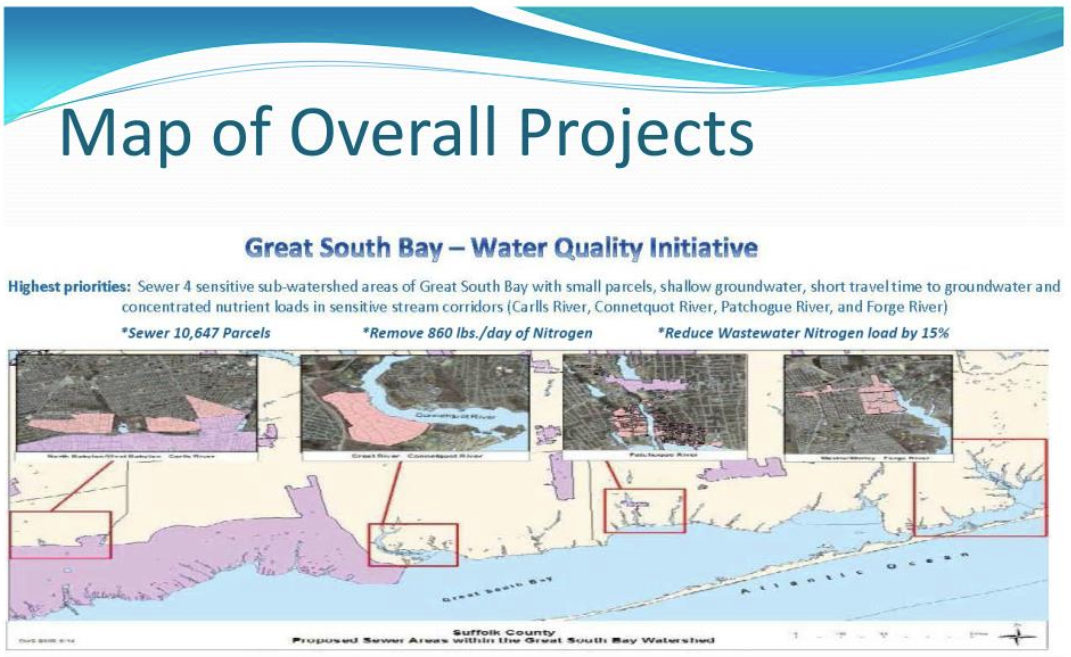
An excerpt taken from a public presentation given by the County that highlights sewer expansion areas. Source: Suffolk County
Long Island environmentalists like Bob DeLuca, the longtime president and CEO of Group for the East End, a nonprofit advocacy organization based in Bridgehampton, mostly agrees with Bellone’s assessment.
“In a word, yes,” DeLuca told The Foggiest Idea when asked if progress has been made in stopping Long Island’s serious decline in water quality. “Over the course of the last several years, the county and state have been developing the framework that is needed to support a comprehensive re-engineering of our antiquated wastewater infrastructure,” he added. As the studies show, two-thirds of the Island’s nitrogen pollution comes from residential septic systems and cesspools.
To DeLuca, Long Island’s limited infrastructure is “the largest controllable water pollution issue facing the region.”
“It has been more than 30 years since there was the level of research, attention and policy movement on water quality that we are seeing today,” DeLuca noted. As evidence, DeLuca mentioned Suffolk County’s latest water quality management plan, new allowances for an assortment of different wastewater treatment options, and a rebate/loan program intended to help homeowners install these systems because of their high out-of-pocket cost.
Although strides have been taken in recent years to address this problem, some skeptics in the environmental community remain unconvinced that they go far enough because time is not on our side.
Kevin McAllister, founder of the Sag Harbor-based environmental group Defend H2O, called them “baby steps.”
“It’s been a slow process,” said McAllister. “You have to put everything in context, especially when you consider nitrogen loadings,” he said, referring to the influx of the contaminants into Long Island’s waters from land use above.
“While the county has upgraded a few dozen systems, it’s minuscule,” he explained. “These systems have an effective influence in large numbers.” According to McAllister, it would take tens of thousands of new systems to have a meaningful influence in the decades to come. As Newsday has reported, 360,000 homes in Suffolk are not connected to sewers.
The Bellone administration doesn’t necessarily disagree with that argument but believes that they have to do something for the region, regardless of the time frame or the initial scale.
“There is a broad constituency that has concluded that we cannot afford not to act,” said Peter Scully, Deputy Suffolk County Executive for Administration.
A seasoned public servant whose career has spanned town, county, and state governments since 1984, Scully hangs his hat in Hauppauge these days. Prior to taking his county role nearly four years ago, he was the head of the New York State Department of Environmental Conservation’s Long Island office. Whether meant as a compliment or not, media outlets have labeled Scully the “sewer czar.”
Scully told TFI that Suffolk County has a plan that would replace every outdated septic system over a 30-year period in key targeted areas. For now, the administration is working to scale up their initial I/A replacement efforts from dozens of installations to annual numbers in the thousands.
To county policymakers, the goal is to have the program gain momentum over time. A key step to the program’s growth is ensuring the public is on-board.
On Tuesday, January 22, Suffolk County is holding three monumental public referendums in Brookhaven, Islip and Babylon on what would be our region’s biggest sewer expansion since the Southwest Sewer District scandals of the 1970’s.
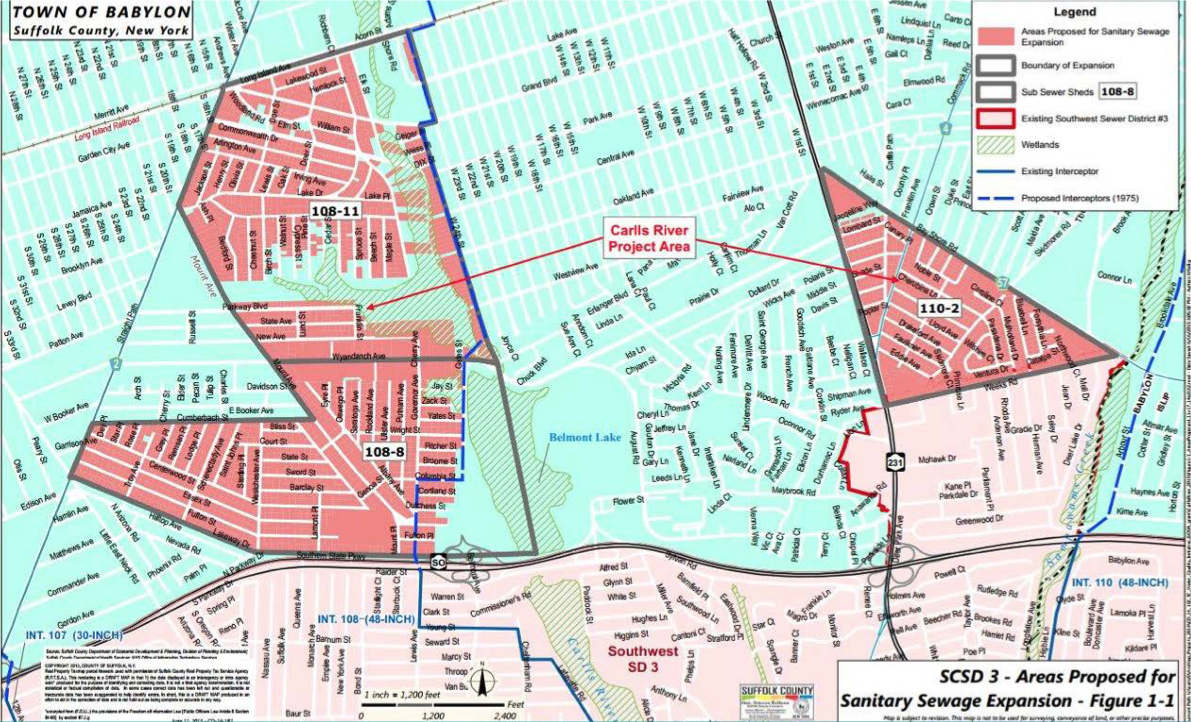
A map showing where Suffolk County is considering expanding sewer infrastructure in the Town of Babylon. Source: Suffolk County
The referendums are asking voters to give the county the authorization to spend almost $390 million in federal and state grants to connect nearly 7,000 homes to sewers. If approved, the money would expand the boundaries of the Southwest Sewer District in West Bablyon, North Bablyon and Wyandach around the Carlls River and in Great River beside the Connetquot River and create a new sewer district and treatment plant in Mastic-Shirley around the Forge River. All told, estimates predict that nearly 250,000 pounds of nitrogen would be removed annually on the south shore.
In addressing the issue, Scully has been taking a big picture approach.“The scientists and academics tell us that the primary concern is nitrogen,” Scully said. “There are some areas in Suffolk County where sewers makes sense.”
Residential areas near existing sewer hookups are good examples of where the new infrastructure would work, he noted. “But there are vast areas where sewering wouldn’t be practical or cost effective,” Scully observed. “It’s in those areas where we are trying to set the stage for I/A projects.”
To him, it’s crucial to provide a policy framework for the public investments that will fund the needed improvements. As he sees it, it’s too much for the homeowners to bear alone.
“It’s unrealistic to expect to burden only those with benefitted parcels with the cost of improvement,” he said. “On the sewer side, you’re looking at costing individuals annually, and on the I/A side, it can be up to $30,000 out of pocket for homeowners. Elected officials will not be comfortable with either of these scenarios.”
Citing the experience of municipalities in Maryland along the Chesapeake Bay that have struggled with similar water quality issues that Long Island faces, Scully has found that establishing a stable, recurring revenue stream is critical to long-range success.
“Grants are nice,” he said, “but until you know you’ll be able to rely on steady and stable revenue, you are not going to be able to plan a program.”
McAllister believes that more has to be done on the legislative side, because implementation—no matter how politically palatable it is—is key.
“I think there needs to be sweeping reform,” he said. He wants local governments to require that new systems be installed whenever homes are sold, and mandate the installation of I/A systems for all new construction. “People say you can’t say that, but do you want to clean the water or not?”
If Long Island is ever going to reverse the pollution has threatened our quality of life, it will take a concerted effort.
“I have been in government for a long time,” Scully said, “and there was never the type of unity of purpose between both the business and environmental communities and public agencies on an issue like this in my experience.”
“We should not ignore the reality that the problem took decades to create,” he added, “and will take decades to resolve.”
COMING SOON: FOAMS, DRUGS, AND SOLVENTS – EMERGING THREATS POSE NEW DANGERS
Richard Murdocco is an award-winning columnist and adjunct professor in Stony Brook University’s public policy graduate program. He regularly writes and speaks about Long Island’s real estate development issues.
You can email Murdocco at Rich@TheFoggiestIdea.org.



